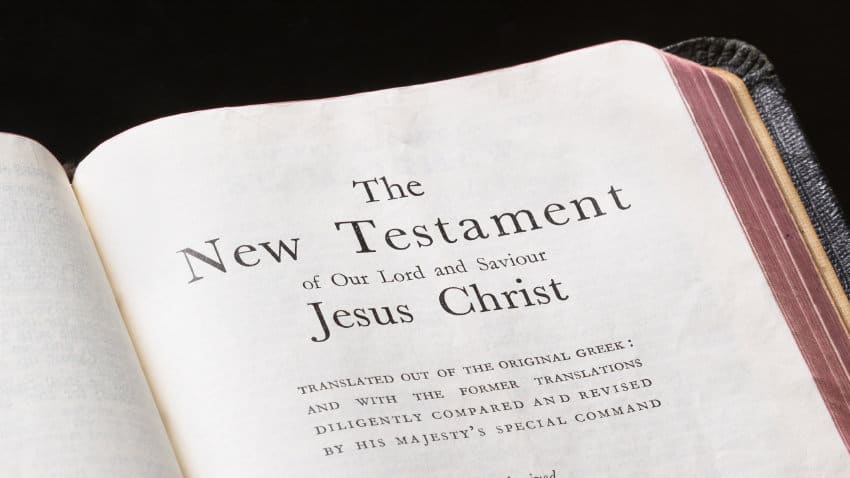
This lesson is the final of three lessons in our series explaining how the Bible is organized. For more help, be sure to review our Bible worksheets on the divisions of the Bible.
- Lesson: Understanding Bible Layout
- Lesson: Understanding the Old Testament
- You are here – Lesson: Understanding the New Testament
TARGET AGES: 10-14
OBJECTIVE: To teach the students about the organization of the New Testament and how we should live during this time of grace between Jesus’ resurrection and second coming.
MAIN IDEA: The New Testament consists of books written about Jesus’ life and the establishment of the church. It is organized by three main sections that explain who Jesus was and how we should behave as Christians.
SCRIPTURE PASSAGES: John 11:25-27, Acts 2:42-47, Acts 9:1-31, Ephesians 4:2-3, James 1:19-21, 2 Timothy 2:16-17
MATERIAL(S): Dry erase board or poster board, set(s) of blank greeting cards, pens/pencils
Introduction (5 minutes)
OPENING PRAYER: “Lord, we thank you for your word that guides us to truth. We ask your Spirit to clearly speak to us as we discover how and why the New Testament was written. Amen.”
PREVIOUS LESSON REVIEW: Say, “Last week we learned the Old Testament consists of five sections: The books of Moses (Pentateuch), historical books, wisdom and poetry books, major prophets and minor prophets.” Remind students that each book and each section points to the gospel of Jesus Christ through God’s dealings with His people.
Lesson (15 minutes)
- Ask, “How does the New Testament start (with Jesus’ birth and life as told in the Gospels)?” Tell the students that today’s lesson focuses on the sections of the New Testament and how God reveals his plan for mankind through the arrival of Jesus Christ. Say, “We are currently in the New Testament time: the time between Jesus’ death and his return.” Write the three categories of New Testament books on a dry erase board or poster.
- Historical Books (Matthew to Acts): Say, “These books tell us about Jesus’ life, death, and resurrection and the establishment of the New Testament church.” Read John 11:25-27 and Acts 2:42-47. Explain that Jesus’ response to Martha (one of the sisters of Lazarus) in John 11 is the epitome of why he came to earth. Ask, “How did the believers in Acts 2 behave (prayer, sacrifice, praise, fellowship, etc)? We should follow their example of humility in our own church.”
- Paul’s Letters (Romans to Philemon): First, briefly remind students of Paul’s former status and conversion (Acts 9:1-31). Say, “Paul wrote letters to churches (Romans to 2Thessalonians) and individuals (1Timothy to Philemon). However, regardless of his audience, Paul’s letters remind us how to live and act as believers in Jesus.” Read Ephesians 4:2-3.
- Additional Letters (Hebrews-Revelation): Explain that Paul wasn’t the only one who wrote letters – the rest of the books in the New Testament were also letters written by people such as Peter, John, and James, the brother of Jesus. Say, “While we know most of the authors who wrote these books, some are still unknown (e.g. Hebrews). Regardless of the author, these letters also remind us how to live and act as Christians.” Read James 1:19-21.
- Comment, “Because we live after Jesus’ resurrection, we follow the New Testament examples of belief and worship (personally asking Jesus to forgive our sins, full immersion believer’s baptism, personally praying and having the Holy Spirit live in us, etc).” Explain that even though there are differences between the Old Testament and New Testament (e.g. animal sacrifices to atone for sin), we learn from both sections of the bible! Say, “Don’t ever let someone tell you that the Old Testament is irrelevant – remember that all scripture is God-breathed and useful for teaching and understanding (2 Timothy 2:16-17).”
Conclusion and Outreach Activity (25 minutes)
RECAP: The New Testament is set up into three sections: historical books, Paul’s letters, and additional letters. We live in the New Testament time and should strive to live our lives entirely for Christ so others may receive salvation.
GREETING CARDS: Obtain a list of needy children in your community (such as foster children) or orphans living in another country. Take time writing personal messages of encouragement and/or bible verses on blank cards. Before dismissing, specifically pray that the recipients will accept Jesus as their Savior if they do not already know him.
CLOSING PRAYER: “God, we thank you for the opportunity to learn from the bible. We pray that we will be Christ-like examples of your saving grace to everyone we encounter. We also pray for the recipients of the cards; that you will draw them to salvation if they do not already have a relationship with you. Amen.”
